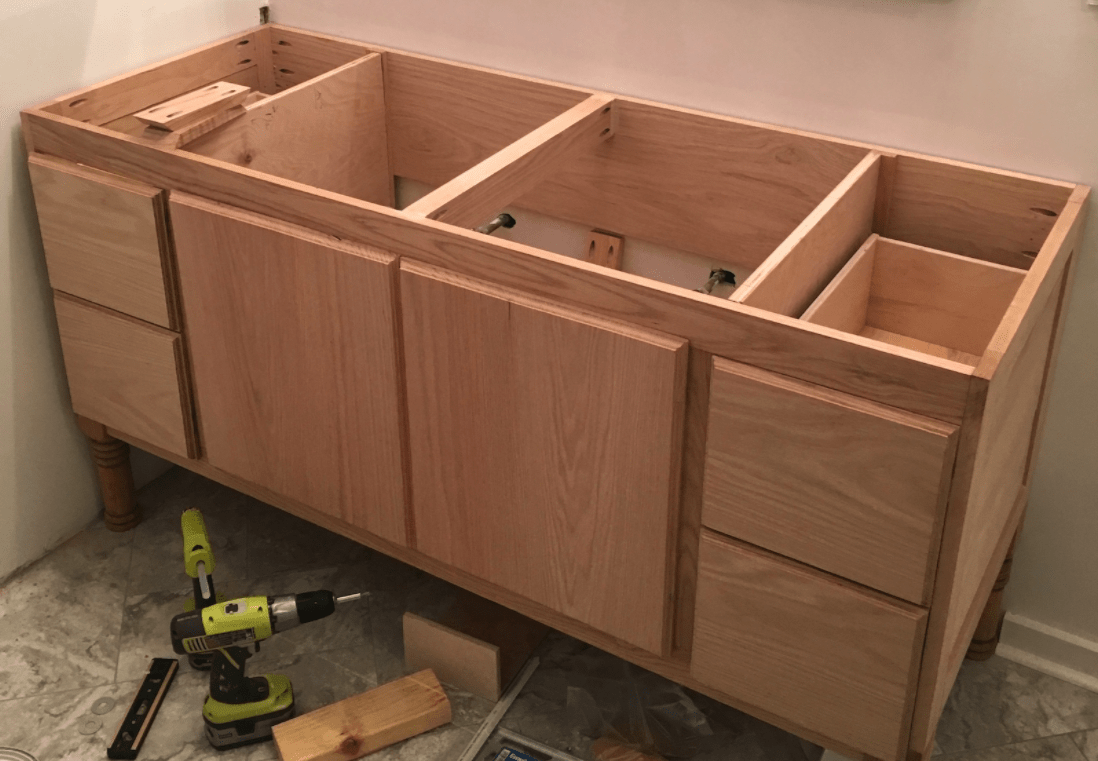Imagine this: you’re finally making progress on your dream bathroom remodel. You’ve chosen the perfect fixtures, the walls are painted the calming, spa-like shade you envisioned, and the tiles are laid – a beautiful sight. But then, a nagging doubt creeps in: “Can I put a vanity on my floating floor? Will it hold the weight?” This is a common dilemma for homeowners, especially those with newly installed floating floors.

Image: www.homedit.com
Let’s dive into the world of floating floors and vanities, exploring the practicality and potential complications. This article will equip you with the knowledge and insights needed to make an informed decision, ensuring a safe, secure, and stylish bathroom for years to come.
Understanding Floating Floors and Their Limitations
Floating floors, also known as “engineered” or “click-lock” floors, have become increasingly popular in recent years due to their ease of installation, affordability, and stylish aesthetics. These floors are essentially layered planks that interlock together, forming a free-floating system that sits atop a moisture-resistant underlayment. This method eliminates the need for nails or glue, making them a popular choice for DIY enthusiasts.
However, unlike traditional subfloor installations, floating floors are designed to move slightly with changes in temperature and humidity. While this movement is usually minimal, it can create a slight “give” under heavy loads, prompting concerns regarding the stability of furniture, such as a bathroom vanity.
Weighing the Pros and Cons: Vanity on a Floating Floor
Before you decide, let’s consider the key factors at play:
Pros:
- Aesthetically Pleasing: Floating floors offer a wide array of styles and finishes, allowing you to create a cohesive design in your bathroom.
- Cost-Effective: Floating floors are generally less expensive to install than traditional subfloors, saving you money on the overall bathroom remodel.
- Easy Installation: Compared to traditional subfloor installation, floating floors are relatively easy to install, making them an attractive option for DIY projects.
Cons:
- Weight Concerns: Floating floors can be susceptible to damage from heavy objects. A vanity, with its weight and potential for movement, can pose a challenge.
- Potential Instability: The “give” inherent in floating floors can make furniture, such as a vanity, feel less stable than if it were placed on a solidly attached subfloor.
- Water Damage: While floating floor manufacturers often offer water-resistant options, it’s crucial to remember that floating floors are not waterproof. Even small leaks can damage the underlayment and cause problems.
Key Considerations: Factors to Evaluate
Now that you’re aware of the pros and cons, how do you decide if a floating floor can support your vanity? Here are some crucial factors to consider:
-
Vanity Weight: The first step is to determine the weight of your chosen vanity. Check the manufacturer’s specifications or weigh the vanity yourself. Remember to factor in the weight of the countertop, sink, and any additional accessories.
-
Floating Floor Structure: Pay close attention to the specific type of floating floor you have installed. Some floors are designed with a thicker underlayment, providing more support and stability. Be sure to consult the manufacturer’s instructions and specifications for recommended weight loads.
-
Vanity Legs and Base: The design of your vanity’s legs or base can significantly influence its stability. A wide base or staggered legs will distribute weight more evenly, minimizing pressure on the floor.
-
Professional Advice: If you’re still unsure, don’t hesitate to seek professional advice. A qualified contractor or flooring specialist can assess your situation and provide tailored recommendations.

Image: laanexa.blogspot.com
Tips for Ensuring Stability: Enhancing Support
While the ideal scenario might involve a solid, non-floating subfloor for your vanity, you can take steps to minimize the risks of instability on a floating floor:
-
Reinforce the Underlayment: Before installing your vanity, consider reinforcing the underlayment beneath it. This can involve adding extra layers of underlayment or applying a plywood panel to provide additional support.
-
Use Thicker Floorboards: If you’re installing a new floating floor, choose thicker floorboards for added strength and durability.
-
Use a Stabilizing Platform: A sturdy platform placed on top of the floating floor can provide localized support for your heavy vanity. This platform can be made of plywood or another suitable material.
-
Securing the Vanity: If possible, secure the vanity to the platform or underlayment. This will prevent it from shifting or wobbling, providing additional stability.
-
Use a Leveling Kit: If your floor doesn’t have the appropriate level, use a leveling kit to ensure that your vanity is positioned securely.
Navigating the Decision: A Balanced Approach
The question of whether to put a vanity on a floating floor doesn’t have a simple yes or no answer. It depends heavily on the specific variables of your bathroom remodel and the level of risk you’re willing to accept.
If your vanity is relatively lightweight, your floating floor is sturdy, and you take the necessary precautions, you can likely install a vanity without major problems. However, if you have a heavy vanity, thin floorboards, or concerns about long-term stability, it may be best to opt for a different type of flooring or consider installing a solid subfloor in the bathroom area where the vanity will be placed.
Can You Put A Vanity On A Floating Floor
Don’t Be Afraid to Ask for Help
Remember, there are many experts available to help you make informed decisions for your bathroom remodel. Don’t hesitate to consult a flooring specialist, contractor, or a trusted friend with experience in DIY projects.
The bottom line is to ensure you feel confident and satisfied with the decision you make. Choose a solution that best suits your needs, budget, and priorities, and most importantly, allows you to enjoy a beautiful bathroom for years to come!






